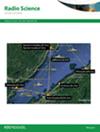模拟无线电波在电离层传播的AU-Ray程序
IF 1.5
4区 地球科学
Q3 ASTRONOMY & ASTROPHYSICS
引用次数: 0
摘要
本文提出了一种用于模拟电离层中HF/VHF无线电波传播的数值射线追踪模型AU-Ray。AU-Ray在完全三维磁离子条件下工作,其原理与其他一些广泛使用的光线追踪代码(例如,PHaRLAP和Proplab-Pro)相似。AU-Ray软件是用c++开发的,完全建立在开源软件包上,这使得它成为其他光线追踪模型的一个有效的独立选择。除了众所周知的经验模式外,该模式还可以处理用户自定义的电离层背景条件源。AU-Ray的使用案例包括分析卫星和地面测量,调查电离层异常,以及支持实时操作。对其他射线追踪模型的验证表明,AU-Ray与Proplab-Pro和PHaRLAP的结果一致,计算效率与PHaRLAP相似,明显高于Proplab-Pro。与PHaRLAP的能力相比,AU-Ray的光子映射工具还有一个附加功能,允许在实验背景条件下解决大量光线的详细传播图。本文章由计算机程序翻译,如有差异,请以英文原文为准。
AU-Ray program for modeling radio wave propagation in the ionosphere
This paper presents a numerical ray-tracing model, AU-Ray, for simulating the HF/VHF radio wave propagation in the ionosphere. AU-Ray operates in fully three-dimensional magnetoionic conditions along similar principles as applied in some other widely used ray-tracing codes (e.g., PHaRLAP and Proplab-Pro). The AU-Ray software has been developed in C++ and built entirely on open-source packages, which makes it an efficient standalone alternative for other ray-tracing models. The model can handle customized user-defined sources for the ionospheric background conditions, in addition to the well-known empirical models. Use cases for AU-Ray include analyzing satellite and ground-based measurements, investigating ionospheric anomalies, and supporting real-time operations. Validation against other ray-tracing models demonstrates that AU-Ray provides consistent results with Proplab-Pro and PHaRLAP and has similar performance in computational efficiency as PHaRLAP, which is significantly higher than that of Proplab-Pro. As an additional feature when compared to PHaRLAP's capabilities AU-Ray's photon mapping tool allows operations to solve large quantities of rays for detailed propagation maps in experimental background conditions.
求助全文
通过发布文献求助,成功后即可免费获取论文全文。
去求助
来源期刊

Radio Science
工程技术-地球化学与地球物理
CiteScore
3.30
自引率
12.50%
发文量
112
审稿时长
1 months
期刊介绍:
Radio Science (RDS) publishes original scientific contributions on radio-frequency electromagnetic-propagation and its applications. Contributions covering measurement, modelling, prediction and forecasting techniques pertinent to fields and waves - including antennas, signals and systems, the terrestrial and space environment and radio propagation problems in radio astronomy - are welcome. Contributions may address propagation through, interaction with, and remote sensing of structures, geophysical media, plasmas, and materials, as well as the application of radio frequency electromagnetic techniques to remote sensing of the Earth and other bodies in the solar system.
 求助内容:
求助内容: 应助结果提醒方式:
应助结果提醒方式:


